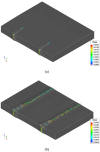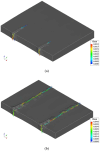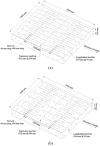Finite element modeling of active cracking in actively reinforced concrete pavement slab exposed to fluctuating temperature
- PMID: 39068293
- PMCID: PMC11283539
- DOI: 10.1038/s41598-024-68414-7
Finite element modeling of active cracking in actively reinforced concrete pavement slab exposed to fluctuating temperature
Abstract
The continuously reinforced concrete pavement (CRCP) system grapples with challenges such as non-uniform transverse crack patterns and the need for substantial reinforcement. Field research on the Belgian CRCP sections along motorway E313 indicates that active cracking induced by partial surface saw-cuts consistently leads to transverse crack patterns. This study introduces an innovative modification to the CRCP: the actively reinforced concrete pavement design (ARCP). The ARCP leverages partial surface saw-cuts to reduce reinforcement needs by replacing continuous-length steel bars with partial-length counterparts. The main objective of the present study is to develop a 3D finite element (FE) model capturing the active cracking behavior of ARCP under realistic external temperature variations. Comparative analysis with CRCP considers early-age crack patterns, crack strain development, and the distribution of maximum steel stress for different steel ratios (0.67%, 0.75%, and 0.85%). FE simulation results align with field data, indicating that ARCP exhibits similar early-age cracking behavior to CRCP but with a significant 24 to 42% reduction in total reinforcement. This innovation presents a promising avenue for addressing CRCP challenges while optimizing material usage in pavement construction.
Keywords: Active cracking; Advanced reinforced concrete slab; Finite element simulation; Partial surface saw-cuts.
© 2024. The Author(s).
Conflict of interest statement
The authors declare no competing interests.
Figures





























References
-
- Kim, S.-M., Cho, Y. K. & Lee, J. H. Advanced reinforced concrete pavement: Concept and design. Constr. Build. Mater.231, 117130 (2020).10.1016/j.conbuildmat.2019.117130 - DOI
-
- Kashif, M., et al. Early-age cracking behavior of advanced reinforced concrete pavement under environmental loading. in IABSE Congress: Structural Engineering for Future Societal Needs. 2021. International Association for Bridge and Structural Engineering (IABSE).
-
- Kashif, M. et al. Evaluating the early-age crack induction in advanced reinforced concrete pavement using partial surface saw-cuts. Appl. Sci.11(4), 1659 (2021).10.3390/app11041659 - DOI
-
- Ouzaa, K. & Benmansour, M. B. Cracks in continuously reinforced concrete pavement. Arab. J. Sci. Eng.39(12), 8593–8608 (2014).10.1007/s13369-014-1442-7 - DOI
-
- Ren, D., Optimisation of the Crack Pattern in Continuously Reinforced Concrete Pavements. 2015, Ph.D. Thesis,Technische Universiteite Delft, The Netherlands.
LinkOut - more resources
Full Text Sources

